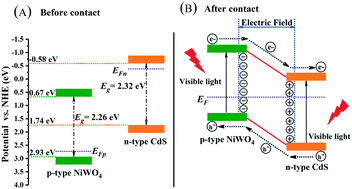Accelerated charge transfer via a nickel tungstate modulated cadmium sulfide p–n heterojunction for photocatalytic hydrogen evolution
Abstract
Improving the efficiency of charge separation is an important aspect in photocatalysis. With NiWO4 modulation, the results of the Mott–Schottky test, short fluorescence lifetime (1.87 ns), faster electron transfer rate constant (KET = 2.82 × 108 s−1), larger efficiency of electron injection (ηinj = 52.7%), high photocurrent response, smaller transfer resistance (Rfilm = 2785 Ω cm2) and reaction resistance (Rct = 1.74 Ω cm2) showed that a new interface electric field was established and a more effective thermodynamic charge transfer path was formed. This evidence greatly supported the fact that the separation and transfer of space charges over CdS p–n were accelerated via NiWO4 modulation. The [CdS/NiWO4 (30%)] sample had the best H2 production performance, namely, the maximum H2 production in 5 hours was 757 μmol, which was 7.35 times higher than that of pure CdS nanorods. Moreover, a series of characterization results also showed that the NiWO4 decorated CdS p–n heterojunction improved the efficiency of photo-generated charge separation and the SEM, XRD, TEM, EDX, XPS, UV-vis DRS, transient fluorescence, electro-chemistry etc. results were in good agreement with each other.

- This article is part of the themed collection: Photocatalysis


 Please wait while we load your content...
Please wait while we load your content...